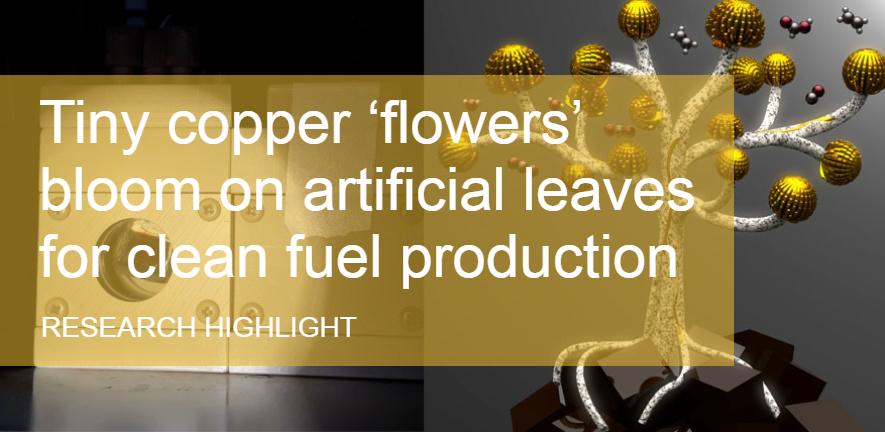
Tiny copper ‘nano-flowers’ have been attached to an artificial leaf to produce clean fuels and chemicals that are the backbone of modern energy and manufacturing.
The researchers, from the University of Cambridge and the University of California, Berkeley, developed a practical way to make hydrocarbons – molecules made of carbon and hydrogen – powered solely by the sun. The device they developed combines a light absorbing ‘leaf’ made from a high-efficiency solar cell material called perovskite, with a copper nanoflower catalyst, to convert carbon dioxide into useful molecules. Unlike most metal catalysts, which can only convert CO₂ into single-carbon molecules, the copper flowers enable the formation of more complex hydrocarbons with two carbon atoms, such as ethane and ethylene — key building blocks for liquid fuels, chemicals and plastics.
Almost all hydrocarbons currently stem from fossil fuels, but the method developed by the Cambridge-Berkeley team results in clean chemicals and fuels made from CO2, water and glycerol – a common organic compound – without any additional carbon emissions.
The study builds on the team’s earlier work on artificial leaves, which take their inspiration from photosynthesis: the process by which plants convert sunlight into food
We wanted to go beyond basic carbon dioxide reduction and produce more complex hydrocarbons, but that requires significantly more energy.”
"his project is an excellent example of how global research partnerships can lead to impactful scientific advancements. By combining expertise from Cambridge and Berkeley, we’ve developed a system that may reshape the way we produce fuels and valuable chemicals sustainably. Dr Virgil Andrei, Yusuf Hamied Department of Chemistry
Andrei, a Research Fellow of St John’s College, Cambridge, carried out the work as part of the Winton Cambridge-Kavli ENSI Exchange programme in the lab of Professor Peidong Yang at University of California, Berkeley. By coupling a perovskite light absorber with the copper nanoflower catalyst, the team was able to produce more complex hydrocarbons. To further improve efficiency and overcome the energy limits of splitting water, the team added silicon nanowire electrodes that can oxidise glycerol instead. This new platform produces hydrocarbons much more effectively — 200 times better than earlier systems for splitting water and carbon dioxide.
“This project is an excellent example of how global research partnerships can lead to impactful scientific advancements,” said Andrei. “By combining expertise from Cambridge and Berkeley, we’ve developed a system that may reshape the way we produce fuels and valuable chemicals sustainably.”
The research was supported in part by the Winton Programme for the Physics of Sustainability, St John’s College, the US Department of Energy, the European Research Council, and UK Research and Innovation (UKRI).
Read the full University of Cambridge article
Read the research paper: ‘Perovskite-driven solar C2 hydrocarbon synthesis from CO2.’ Virgil Andrei et al. Nature Catalysis (2025). DOI: 10.1038/s41929-025-01292-y
Image credit: Solar fuel generator, Virgil Andrei

